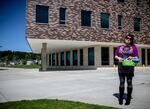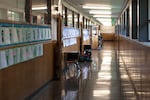Once again, Samantha Piers-VanderPloeg knocks on an apartment door in east Multnomah County. She’s there to visit Zahira Desphy, one of her students.
The previous week, she knocked so loudly neighbors came out to see what was wrong. Zahira was in such a deep sleep she didn’t hear her teacher pounding away and never came to the door.
But this time is different. Piers-VanderPloeg texted Desphy to let her know when she’d arrive. She knocks just a couple of times before Desphy and her mother answer.
They talk for almost an hour, despite the light rain. They touch on family, graduations and their shared love of color-coded notes. School barely comes up, save for Piers-VanderPloeg lightly teasing Desphy about sleeping in.
“She's definitely somebody that you can talk to almost about everything,” Desphy said of her teacher from a community college program designed to help high school students graduate. “Considering she knows I had a big struggle with school … she made it easier.”
The home visit is illustrative of the unconventional work many Oregon educators have undertaken since Gov. Kate Brown ordered public schools to close to stem the spread of the novel coronavirus.
The state Department of Education mandated that districts adopt distance learning programs to keep all students engaged. Nevertheless, officials say they expect the interruption to further exacerbate inequities, with students of color, those experiencing poverty and those on special education plans falling even further behind their more advantaged peers.
In a state with one of the nation’s worst rates of chronic absenteeism and the No. 47 graduation rate, the impact is particularly wrenching for teens whose ties to school were already tenuous and who now have almost entirely lost face-to-face contact from educators nudging and cheering them across the finish line to a diploma.
“It’s very easy to fall behind — that’s the one thing that kind of scares me,” Desphy said. “I’ll miss maybe two calls, and I’ll be maybe two or three assignments behind already. It’s more demanding.”

After failing to graduate from Reynolds High School after four years, Zahira Desphy is trying for a fifth year to earn her diploma. The coronavirus-caused switch to distance learning has made graduating harder for her and thousands of other students with tenuous ties to school.
Beth Nakamura / OPB
Piers-VanderPloeg works with such students through Mt. Hood Community College's Gateway to College program, which aims to help teens who are behind in credits or otherwise disengaged.
“These are students who have dropped out or are on the verge, they’re disengaged, they’re not passing classes,” Piers-VanderPloeg said.
Oregon has a particularly poor track record at graduating students who are Black, Native American, low-income or unhoused, with fewer than 75% of them making it to the finish line in four years. Even after a fifth year of high school, one of every three special education students and students who didn’t master English as a second language before high school doesn’t earn a diploma.
Oregon’s graduation rate for white students — 80% for the class of 2019 — ranks second-worst in the country.
The state's standards are lower this year: Amid the coronavirus pandemic, any high school senior who had at least a D as of mid-March in every course required for graduation is guaranteed a diploma.
Still, for those who need to bring up a grade in at least one course to qualify make it across the finish line, staying connected to school despite a lack of digital devices, a fast internet connection, adult supervision or emotional and motivational support adds to the struggle.
Even more Oregon teens could end their high school years on a path toward limited post-secondary options and with doors to good jobs closed to them.

Zahira Desphy is earning her high school diploma with the help of a Mt. Hood Community College program that aims to help teens who are behind in credits or otherwise disengaged from school.
Beth Nakamura / OPB
Desphy participated in track and field and an assortment of extracurricular activities at Reynolds High School. But she regularly neglected her schoolwork, which led to her failing to graduate in 2019.
She’s on track to earn her diploma now. But it’s been a long road. And, with student-teacher communication moved largely online via weekly Zoom meetings, finishing high school is even less likely for students like her.
Distance learning a challenge for unhoused high schooler
Before the pandemic, life at Mountainside High School was Jace Russell’s one constant.
“When I went to school, I could socialize. I could focus on doing something other than sleeping or trying to drive around and find a spot where I wouldn’t be bothered,” Jace, 16, said. “I could focus on schoolwork, see my friends and just have a release.”
Jace’s mind raced when he learned about the school closure order. Where would he go in the morning? How would he eat? How would he avoid contracting COVID-19?
He’s one of about 2,000 unhoused students the Beaverton School District has identified. For the last six months, Jace has been living out of his car.
“I didn’t want to be by myself in a car. I didn’t want to catch the virus,” Jace said. “I was trying to find a place to stay. I found a place to stay for a couple of weeks but then I was back in my car again.”

Jace Russell, a junior at Beaverton's Mountainview High School, was jolted to learned school would close and his education would switch to remote mode in mid-March. Before the pandemic hit, he was succeeding in classes and on track to graduate.
Mark Graves / The Oregonian/OregonLive
The Mountainside junior crashes on friends’ couches on weekends. During the week, Jace completes assignments as best he can.
He managed to borrow a Chromebook from the district just before spring break. But Jace doesn’t have reliable internet access.
A vice principal worked out a temporary solution. Jace does what he can with a pencil and paper, then submits whatever assignments he can complete that way. He checks email on his phone daily.
On a recent Friday morning, the device buzzed and signaled: “Unknown Caller.”
Jace knew Beaverton teachers mask their phone numbers when they call students. But he’d never met Rita Morgan, who was on the other end of the line.
She’s Mountainside’s community liaison, mostly performing outreach to unhoused students. Morgan is also the adviser for Club Hope at Mountainside, an organization that provides care packages for students whose achievement despite their circumstances inspires their peers.
Jace was one such student.
He was wary of Morgan when she called but eased up when she emailed him from her district account. They agreed to meet at Mountainside.

Rita Morgan, a sophomore social studies teacher at Mountainside High School in Beaverton, is also the adviser for Club Hope, which provides care packages — called "hope baskets" — for unhoused students.
Mark Graves / The Oregonian/OregonLive
There, Jace was to pick up a care package — hope baskets, the club calls them.
Once they met, Jace opened up. He told Morgan he’s been on his own since he was 14. He was expelled from Aloha High School and spent six months at a military school near Bend.
The program taught Jace discipline. It also helped him recover enough credits to enroll at Mountainside as a junior. So far, he’s on track to graduate. Reliable access to electricity and the internet would make it easier to stay on course.
“Power is a huge thing because I don’t necessarily want to use my car battery when my car’s often parked,” Jace said.
He asked Morgan if she knew where he could find a portable internet hotspot. She recalled the district’s IT team had a few to spare and told Jace she’d ask for one.
How much was Morgan going to tell the tech team about his situation, Jace asked? As little as possible, Morgan assured him.
“They don’t need to know. That’s his story to tell. Not mine,” she said.
Schools navigate poverty, homelessness to help students
Morgan’s mornings are flush with classroom Zoom sessions. On a good day, she said, maybe 30% of her students show up.
She spends afternoons tracking the ones who don’t. Because of her background working with unhoused students, Morgan first tries to figure out if something has changed at home.
Maybe the family breadwinner has been placed on furlough. Or a student is suddenly thrust into employment to help make ends meet. Morgan’s primary goal is to ensure her students are mentally and physically OK.
“Have some things changed for my students? I need to help with their well-being, too,” she said.
But sometimes a kid just slept in. Other times, students feel overwhelmed or burnt out when their living room and classroom are one in the same.
Morgan coached one girl through a case of writer’s block in late April, urging her to type something, anything out.
“Sometimes you’ve just got to try and get something on a Google Doc,” Morgan recalls telling the student.

Lately, only about one-third of Morgan's students are showing up to class Zoom sessions. She regularly considers what factors might contribute to those absences. “Have some things changed for my students? I need to help with their well-being, too."
Mark Graves / The Oregonian/OregonLive
Those problems aren’t exclusive to suburban districts.
In rural Coquille, Winter Lakes High School Principal Jennifer Sweeney said the shift to distance learning has highlighted existing issues such as a lack of access to food, school supplies and the internet.
Largely rural Coos County has the fifth-highest rate of childhood poverty in Oregon, at 24%, according to the most recent Census Bureau estimates, from 2018. That helps explain why a higher share of teens there than in any other county — 37% — don’t graduate from high school on time.
Coquille is the Coos County seat, and its school bus drivers deliver meals and learning packets to children via their traditional routes. Still, that leaves a large group of students without consistent contact with their educators.
“Part of our disconnect has been the students who don’t come to school [for meal or homework pick-ups] and are not within walking distance or short driving distance,” Sweeney said.
'Meet them where they're at'
In McMinnville, every single Latino high school student still learning English as a second language is juggling a job and schoolwork.
Officials in the district say they’ve made contact with all but about 2% of their 6,800 students. Kourtney Ferrua, the director of curriculum and instruction, said 44 of the high school’s nearly 2,200 students are unaccounted for.
She said relationships district employees built with students and families over the years have been essential in keeping track of those who might otherwise fall through the cracks.
Teachers and administrators, particularly those who work with at-risk student groups like English learners and those experiencing poverty, can more easily talk brass tacks with kids. Those adults know the struggles students face, whether they’re tasked with watching younger siblings at home or they work to help support their family.
“We need to be flexible in the opportunities we provide so we can be meeting them where they’re at,” Ferrua said.
Some teachers don’t hear from students who’ve started working to earn money for their families amidst the downturn until they’ve clocked out for the day, which means assignments can come rolling in as late as 10 p.m.
When teachers in McMinnville don’t hear from their students, that triggers a process that starts with a phone call to the child’s home number. In “the vast majority of cases,” program coordinator Kristian Frack said, that does the trick.
Parents of younger children might forget their child had an assignment due. Older kids might keep their parents out of the loop when it comes to schoolwork — Frack said phone calls and messages typically get those parents more engaged.
“It’s as easy as leaving a message and saying, ‘Hey, it’s me. It’s your child’s teacher and I’ll call you back at this time,’” Frack said. “It’s rare that a parent will not want to do what’s in the best interest of their child. … We try to turn every rock over several times.”
Related: Oregon's Teacher Of The Year: Distance Learning Is Failing Vulnerable Students
Not all educators in Oregon are as equipped or as willing to do family outreach or work after hours as those in McMinnville, a district noted for its sky-high achievement scores and graduation rates for low-income and Latino students compared to other Oregon districts.
Some teachers who’ve been forced to switch to distance education without the tools or training to do so say they’re struggling under a crushing workload.
Educators may also be homeschooling their own children. They may not have working phone numbers for many parents. And they may not be required or supported by district leaders to seek out students who don’t log into Zoom or whose parents don’t retrieve packets from a weekly school drive-thru line.
Before students were caught up in the disruption of a global pandemic, teachers in many districts had made their classrooms a stable, reassuring environment. They couldn’t control whether a student had a roof over their head or breakfast before the bell rings. But the classroom provided some semblance of consistency.
With coronavirus ravaging the education system, however, teachers have lost control over the learning environment.
‘I like to be taught in person’
Vicki Mashos teaches social studies at North Salem High School. She’s also responsible for an advisory class and, since schools were ordered closed, she’s been in touch with 14 of the 15 seniors in the group. It’s a smaller number of students to manage compared to the 175 she teaches, and she’s been able to build strong relationships with her advisees over their high school careers.
She’s now giving most of them good news — they were passing a class on March 13, the last day Oregon schools were open, so they will get a passing grade for the year.
“When I can find information and say, ‘Hey, you are done with this one, and great job!’” Mashos said. “It’s kind of like being a personal trainer.”
But in the new mode, student work can be inconsistent, she said. Distance learning has not been helpful for everyone.
“For our students that have really had a difficult time already, in many ways, even though there are opportunities, it’s been difficult for them and I’m not seeing a lot of progress there, unfortunately,” Mashos said.
North Salem senior Relintina Schilling is one marketing class away from graduation.
“If I have to be honest, distance learning is really hard compared to being in a classroom,” Schilling said. “I like to be taught in person … it’s easier for me to understand what the teachers are trying to say and show to us.”
The pandemic has given her a chance to spend more time with her family and help take care of her infant nephew, but she says it’s an obstacle to finishing high school.
“It’s blocking my way of … ending my year strong,” Schilling said.

A school hallway sits empty.
Rob Manning / OPB
About This Project
The COVID-19 crisis has disrupted education across Oregon. Over the next weeks and months, The Oregonian/OregonLive and Oregon Public Broadcasting are teaming up to examine the impact in a state already struggling with chronic absenteeism and one of the nation’s worst graduation rates.Are you a student, parent or teacher? We’d love to hear from you. Contact reporters Elizabeth Miller and Eder Campuzano.